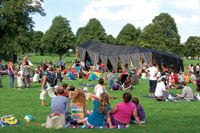In the public eye
Public art is all too often derided and overlooked by a sneering national press, but it’s time we appreciated the breadth of experience on offer says Claire Doherty

Of all artforms, public art is perceived as the uninvited guest. Characterised in the public imagination by monumental scale, the popularised view of public art is that of something thrust upon us. Take Anish Kapoor’s ‘Orbit’ for the Olympic Park – the press cast the work as an art experience imposing on our public space. But in the past two decades, through its association with contemporary art biennials, off-site gallery programmes and broader cultural regeneration schemes, the public art sector has seen the diversification of artistic approaches and professional expertise.
Within the sector internationally, public art is no longer referred to as a single artform. It is understood as a variety of forms and approaches that engage with the sites and situations of the public realm. These range from artists operating within design teams or planning departments, such as Kerstin Bergendal’s ‘Trekroner Art Plan’ in Denmark or process-based projects, where the artwork constitutes a collective, participatory process, such as Amy Franceschini’s ‘Victory Garden’, which saw the transformation of San Francisco’s City Hall plaza into an allotment. There are also semi-permanent architectural structures that host time-based events, such as raumlaborberlin’s inflatable pavilion ‘Rosy’, which is touring London parks. Then there are the most fleeting of sculptural interventions such as One Day Sculpture in New Zealand, a year-long series of 20 projects across five cities, each of which lasted for only 24 hours. It’s the vitality and relevance of commissions like these that show the diversity of artistic approaches responding sensitively to local context.
ADDING UP THE NUMBERS
Public art in the UK has clearly benefited from public and private sector investment in regeneration initiatives over recent years. Unsurprisingly, the sector is at risk: a decrease in regeneration schemes and public sector cuts across capital programmes will impact heavily on artists. As a result, we may be about to witness a return to a narrow definition of public art. When budgets are curtailed in terms of staff resources, maintenance and public engagement, there may be a greater insistence on what appear to be low-risk, low-maintenance public art projects; we may see less support for more radical and experimental approaches, which have the potential for a greater, longer-lasting social impact.
MOULDING THE PUBLIC MOOD
One possible move to protect our public art sector would be a fundamental shift in thinking about the ‘time’, rather than simply the ‘space’, of public art. Artists need time to get beneath the skin of a place; a public artwork comes to fruition over time, just as it does in the studio, through false starts, exchanges and dreaming is part of that process. We need to tackle the perception that a public art work should be permanent; why should the legacy of a temporary public artwork not be as keenly felt culturally as a permanently sited commemorative statue? Why should public art not have time limits? Places are not static sites onto which public art is grafted; rather, regeneration is a continuous process to which artists are contributing.
The counter-cultural Slow Movement offers one possible model for rethinking public art commissioning with an emphasis on local resources, sustainability, shared hospitality and the value of communal experience. Though the coastal contexts for two of our current projects at Situations – Weston-super-Mare and Oslo – are distinct, both offer the opportunity to consider public art which advocates ‘slow time’ through a series of remarkable gathering points and dispersed interventions. At its most challenging, public art is the beginning of a conversation that changes the way in which we interact with the world around us; at its most conventional, it is a full stop.
Join the Discussion
You must be logged in to post a comment.